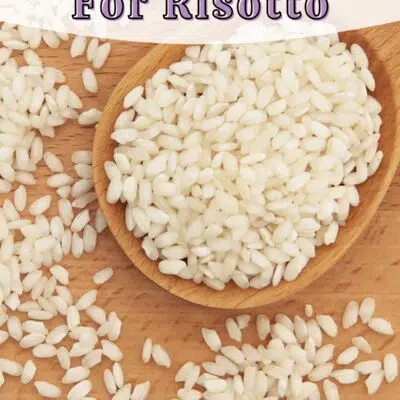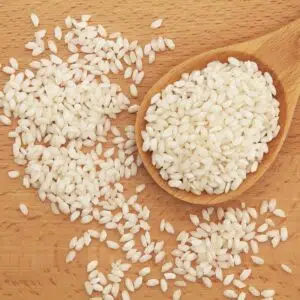The best rice for risotto are the varieties that have a high starch content in order to achieve that wonderfully creamy texture! If you want the best possible dish, you need to have the best ingredients to start. Here's a list of all of the types of rice that will make a perfect serving of risotto!
Best Rice for Making Risotto
Is there anything better than a warm and comforting bowl of risotto? While this dish is not difficult to prepare, it does matter what type of rice you choose to cook with!
At its core, risotto is simply rice that is cooked in broth. However, the starch content of the kind of rice you use is incredibly important because it gets rubbed off during all of the constant stirring. This then thickens the broth, making the wonderfully creamy texture that we all know and love!

Jump to:
What Rice Varieties Can I Use For Risotto
The best rice used for making risotto has a high amylopectin layer on the outside of the kernel, the translucent portion of the grain. The inside of the kernel has a high amylose content. Amylopectin and amylose are the two pectins that combine to make the starch that is needed for a great risotto!
Additionally, the grain size needs to be short to medium in length and relatively thick.
If you love risotto and want to perfect your cooking technique, make sure to check out my ultimate guide to cooking risotto!
Arborio
Arborio is the most readily available short-grain Italian rice available to us here in the United States. It is available for purchase at most grocery stores and supermarkets in the rice aisle.
Arborio rice has a large, rounded grain with high starch content. The rice readily absorbs the liquid added to the risotto.
Brown Arborio rice can also be used for risotto, but since the bran and fiber are still contained in the grain, the results will not be as creamy as the classic risotto using short-grain white rice (like white Arborio).
Carnaroli
Carnaroli is argued by many to be the best rice variety for making superior creamier risotto. It is medium-grain Italian rice that is more forgiving when cooked.
The rice retains its al denté texture (without getting mushy) easier than our more commonly available Arborio and also Vialone Nano. Carnaroli and Vialone Nano also have a higher starch content than Arborio.
Vialone Nano
Vialone Nano is medium-grain Italian rice that is also one of the best rice varieties for risotto. It holds its shape well while absorbing liquid quickly for a shorter cooking time than Carnaroli.
Maratelli
Maratelli is medium-grain Italian rice that holds its shape well when used for risotto. It is more forgiving rice when overcooked.
Maratelli, Carnaroli, and Vialone Nano are considered the three best rice for risotto.
Padano
Padano is a rounded medium-grain Italian rice that absorbs liquid well and is also popular in Italian soups as well as risottos.
Roma
Roma is an Italian rice that absorbs large amounts of liquid well for risottos and timbales.
Newer Varieties
These are the main types of short to medium-grain Italian rice that are high in starch content and widely used in making risotto.
Other kinds of rice include Baldo, which is a newer variety of rice. Baldo also has a shorter cooking time, but I have only seen it available for purchase in specialty shops and online.
Cal Riso rice is also a new rice variety, a hybrid of Californian and Italian rice developed in California.
I hope to see this one more readily available in stores, but at this point, I have only found it in whole foods stores and from Bayliss Ranch of CA. *I have also seen this rice variety called Calrose, however, 'Calrose' is also an Asian rice name.
Risotto Rice Substitutes
Can you use white rice for risotto? I wouldn't try with long-grain white rice! The starch content is not the same, and the grains are composed of more amylose than amylopectin.
This means that white grain rice kernels are more suited to being separate than creamy.
Here are some substitutions that do work:
Bulgar Wheat, also known as cracked wheat in the United States, is a whole wheat grain product from ground wheat berries. It's a super healthy risotto option and adds a delicious nutty flavor.
As well as Brown Rice, Sushi Rice, Quinoa, Valencia Rice, Israeli Couscous, Farro, and Pearled Barley.
❓ Recipe FAQs
Nope! You need to specifically use a variety of rice that is short or medium in length with high starch content. This is what creates the thick sauce that risotto is known for!
Carnaroli, Vialone Nano, and Maratelli are all great options for making risotto if you don't have any arborio on hand!
Arborio is the most popular rice for making risotto as it is easily found in any grocery store and yields great results!
Now that you know the best rice for risotto, what kind are you going to make first? Leave a comment down below and let me know your favorite types of risotto!
📖 Helpful Cooking Guides
- Best Type of Meat for Meatloaf - Make sure you start off with the right meat in order to make a meatloaf that is moist, juicy, and firm!
- Best Potatoes for Baked Potatoes - The best potatoes for baked potatoes are the ones that yield an extra fluffy interior with a crisp exterior!
- Best Cheese for Burgers - For the ultimate cheeseburger, make sure you use the right kind of cheese!
- Best Cheese for Macaroni & Cheese - Not all cheeses melt the same, and for mac & cheese you'll want to use a variety that will give you an ooey-gooey bowl of perfection.
- Best Potatoes for Mashed Potatoes - For mashed potatoes, you'll need to choose either a Yukon gold or a russet!
- Best Way to Reheat Steak - This guide will show you how to reheat your leftover steak without drying it out!
Do you love a recipe you tried? Please leave a 5-star 🌟rating in the recipe card below and/or a review in the comments section further down the page.
Stay in touch with me through social media @ Pinterest, Facebook, Instagram, or Twitter! Subscribe to the newsletter today (no spam, I promise)! Don't forget to tag me when you try one of my recipes!
📖 Recipe Card
Best Rice For Risotto: Parmesan Risotto (+Other Rice Varieties)
Ingredients
- 4 cups chicken broth (heated to a low simmer in a saucepan)
- 1 tablespoon olive oil (extra virgin)
- 1 cup Arborio rice
- ¼ cup shallots (or white onion - finely minced)
- 2 cloves garlic (finely minced)
- ¼ cup dry white wine (up to ⅓ cup - I used Pinot Grigio)
- 2 tablespoon butter (salted, in 1 tablespoon pats)
- 2 tablespoon Parmigiano Reggiano cheese (plus more for garnish when served, if desired)
- salt & pepper (to taste)
(Note: 2x or 3x only changes the ingredient list)
Instructions
- Bring a large skillet or frying pan to medium heat. Add olive oil, then add garlic and shallots. Cook until softened, about 1-2 minutes.
- Add your Arborio rice and cook the kernels, stirring occasionally, for about 1-2 minutes.
- Add the dry white wine and cook for one minute, stirring frequently.
- Add one cup of the broth and stir occasionally while the rice cooks and absorbs the liquid. Ladle in additional amounts initially in approximately ½ cup portions. Allow the rice to absorb the liquid as added.
- When your rice has cooked for about 15 minutes, the rice will slow down on absorbing the liquid when added. Use smaller ¼ cup portions as you near the end of the cooking process.
- You are looking for an al dente texture to your rice, and I start checking for this at the 15 - 16 minute mark. Test an individual rice grain for the soft texture that still retains a semi-firm core to the grain.
- Once your rice has reached an al dente texture, remove the risotto from the heat and add the butter and Parmigiano Reggiano. Stir to combine and serve on warmed plates with additional freshly grated Parmigiano Reggiano cheese, if desired.



Comments
No Comments